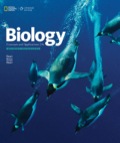
Concept explainers
Introduction:
All the organisms present in the environment is composed of a cell. The organisms are classified into two types. These are prokaryotes and eukaryotes. Prokaryotes are the organisms that do not contain a well-defined nucleus. However, eukaryotes have a well-defined nucleus properly enclosed in a nuclear membrane. A
Answer to Problem 1SQ
Correct answer:
All the fungi are heterotrophs as they depend on other organisms for food. They are not capable of producing their own food. Hence, the correct answer is option c.
Explanation of Solution
Reason for correct answer:
Option c. is given as “are heterotrophs.”
The organisms that are capable of preparing their food by the process of photosynthesis are termed as autotrophs. However, the organisms that cannot prepare food and depend on other organisms are termed as heterotrophs. Fungus is also a heterotroph as it depends on other organisms for food.
Reason for incorrect answer:
Option a. is given as, “are multicelled.”
The organisms that contain one cell are called unicellular or single-celled organisms. However, the ones that are composed of more than one cell are called multicelled organisms. Fungi can be both single-celled and multicelled. The fungi with one cell are called yeasts. Hence, option a. is incorrect.
Option b. is given as, “form flagellated spores.”
Fungi have the ability to produce spores. They can produce a variety of spores such as both flagellated and non-flagellated spores. Chyratids is the only type of fungi that produce flagellated spores. However, all other types of fungi produce non-flagellated spores. Hence, option b. is incorrect.
Option d. is given as, “all of the above.”
The only correct option that holds correct for fungi is option c. This is because fungi are heterotrophic organisms as they cannot prepare their own food. However, all the other options do not explain the characteristic of fungi accurately. Hence, option d. is incorrect.
Hence, the options a., b., and d. are incorrect.
Fungi are the heterotrophic organisms as they cannot prepare food. They are dependent on other organisms for their nutrition. Thus, the correct option is c.
Want to see more full solutions like this?
Chapter 22 Solutions
EBK BIOLOGY: CONCEPTS AND APPLICATIONS
- Outline the negative feedback loop that allows us to maintain a healthy water concentration in our blood. You may use diagram if you wisharrow_forwardGive examples of fat soluble and non-fat soluble hormonesarrow_forwardJust click view full document and register so you can see the whole document. how do i access this. following from the previous question; https://www.bartleby.com/questions-and-answers/hi-hi-with-this-unit-assessment-psy4406-tp4-report-assessment-material-case-stydu-ms-alecia-moore.-o/5e09906a-5101-4297-a8f7-49449b0bb5a7. on Google this image comes up and i have signed/ payed for the service and unable to access the full document. are you able to copy and past to this response. please see the screenshot from google page. unfortunality its not allowing me attch the image can you please show me the mathmetic calculation/ workout for the reult sectionarrow_forward
- Skryf n kortkuns van die Egyptians pyramids vertel ñ story. Maximum 500 woordearrow_forward1.)What cross will result in half homozygous dominant offspring and half heterozygous offspring? 2.) What cross will result in all heterozygous offspring?arrow_forward1.Steroids like testosterone and estrogen are nonpolar and large (~18 carbons). Steroids diffuse through membranes without transporters. Compare and contrast the remaining substances and circle the three substances that can diffuse through a membrane the fastest, without a transporter. Put a square around the other substance that can also diffuse through a membrane (1000x slower but also without a transporter). Molecule Steroid H+ CO₂ Glucose (C6H12O6) H₂O Na+ N₂ Size (Small/Big) Big Nonpolar/Polar/ Nonpolar lonizedarrow_forward
- what are the answer from the bookarrow_forwardwhat is lung cancer why plants removes liquid water intead water vapoursarrow_forward*Example 2: Tracing the path of an autosomal dominant trait Trait: Neurofibromatosis Forms of the trait: The dominant form is neurofibromatosis, caused by the production of an abnormal form of the protein neurofibromin. Affected individuals show spots of abnormal skin pigmentation and non-cancerous tumors that can interfere with the nervous system and cause blindness. Some tumors can convert to a cancerous form. i The recessive form is a normal protein - in other words, no neurofibromatosis.moovi A typical pedigree for a family that carries neurofibromatosis is shown below. Note that carriers are not indicated with half-colored shapes in this chart. Use the letter "N" to indicate the dominant neurofibromatosis allele, and the letter "n" for the normal allele. Nn nn nn 2 nn Nn A 3 N-arrow_forward

 Biology: The Dynamic Science (MindTap Course List)BiologyISBN:9781305389892Author:Peter J. Russell, Paul E. Hertz, Beverly McMillanPublisher:Cengage Learning
Biology: The Dynamic Science (MindTap Course List)BiologyISBN:9781305389892Author:Peter J. Russell, Paul E. Hertz, Beverly McMillanPublisher:Cengage Learning Biology (MindTap Course List)BiologyISBN:9781337392938Author:Eldra Solomon, Charles Martin, Diana W. Martin, Linda R. BergPublisher:Cengage Learning
Biology (MindTap Course List)BiologyISBN:9781337392938Author:Eldra Solomon, Charles Martin, Diana W. Martin, Linda R. BergPublisher:Cengage Learning Concepts of BiologyBiologyISBN:9781938168116Author:Samantha Fowler, Rebecca Roush, James WisePublisher:OpenStax College
Concepts of BiologyBiologyISBN:9781938168116Author:Samantha Fowler, Rebecca Roush, James WisePublisher:OpenStax College Biology Today and Tomorrow without Physiology (Mi...BiologyISBN:9781305117396Author:Cecie Starr, Christine Evers, Lisa StarrPublisher:Cengage Learning
Biology Today and Tomorrow without Physiology (Mi...BiologyISBN:9781305117396Author:Cecie Starr, Christine Evers, Lisa StarrPublisher:Cengage Learning Biology: The Unity and Diversity of Life (MindTap...BiologyISBN:9781305073951Author:Cecie Starr, Ralph Taggart, Christine Evers, Lisa StarrPublisher:Cengage Learning
Biology: The Unity and Diversity of Life (MindTap...BiologyISBN:9781305073951Author:Cecie Starr, Ralph Taggart, Christine Evers, Lisa StarrPublisher:Cengage Learning





